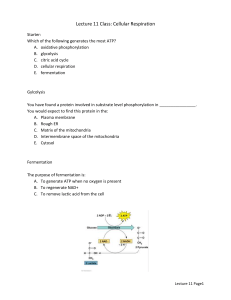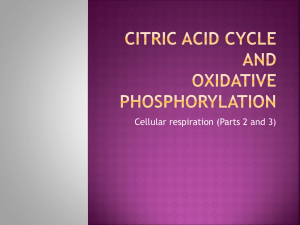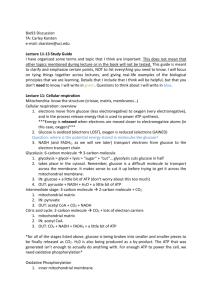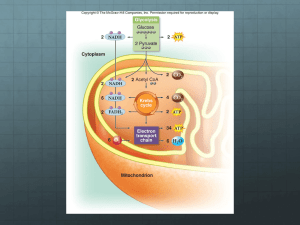RespirationnotesTE
advertisement
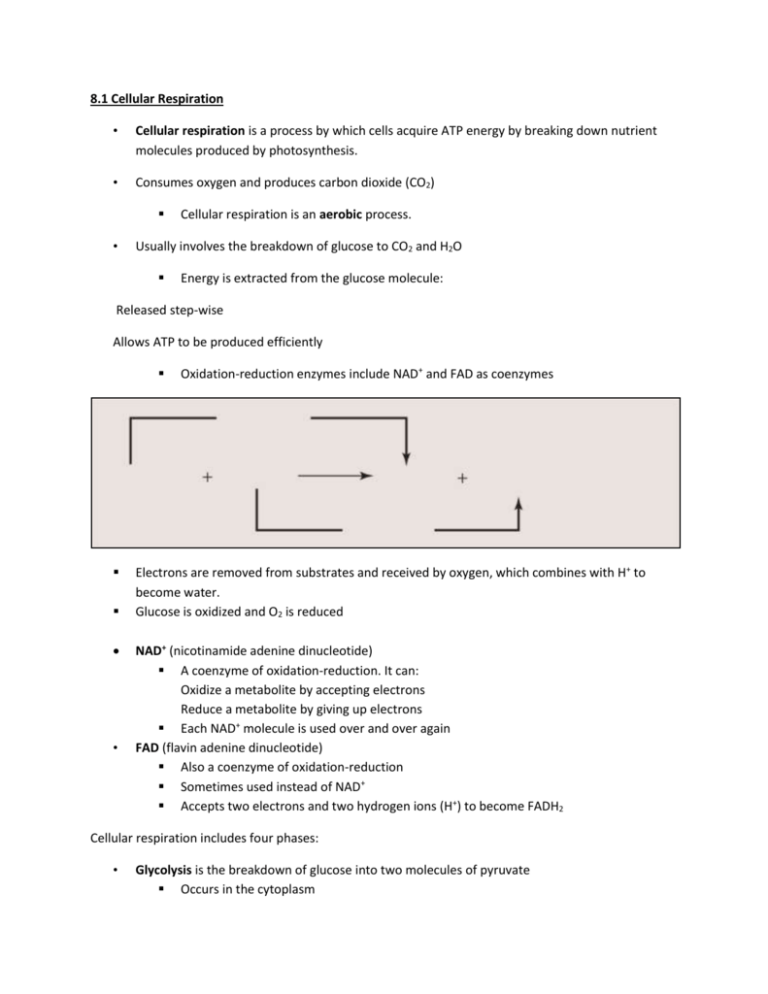
8.1 Cellular Respiration • Cellular respiration is a process by which cells acquire ATP energy by breaking down nutrient molecules produced by photosynthesis. • Consumes oxygen and produces carbon dioxide (CO2) • Cellular respiration is an aerobic process. Usually involves the breakdown of glucose to CO2 and H2O Energy is extracted from the glucose molecule: Released step-wise Allows ATP to be produced efficiently • Oxidation-reduction enzymes include NAD+ and FAD as coenzymes Electrons are removed from substrates and received by oxygen, which combines with H+ to become water. Glucose is oxidized and O2 is reduced NAD+ (nicotinamide adenine dinucleotide) A coenzyme of oxidation-reduction. It can: Oxidize a metabolite by accepting electrons Reduce a metabolite by giving up electrons Each NAD+ molecule is used over and over again FAD (flavin adenine dinucleotide) Also a coenzyme of oxidation-reduction Sometimes used instead of NAD+ Accepts two electrons and two hydrogen ions (H+) to become FADH2 Cellular respiration includes four phases: • Glycolysis is the breakdown of glucose into two molecules of pyruvate Occurs in the cytoplasm • • • ATP is formed Does not utilize oxygen Preparatory (prep) reaction Both pyruvates are oxidized and enter the mitochondria Electron energy is stored in NADH Two carbons are released as CO2 (one from each pyruvate) Citric acid cycle Occurs in the matrix of the mitochondrion and produces NADH and FADH2 In series of reactions, it releases 4 carbons as CO2 Turns twice per glucose molecule (once for each pyruvate) Produces two immediate ATP molecules per glucose molecule Electron transport chain (ETC) Extracts energy from NADH & FADH2 Passes electrons from higher to lower energy states Produces 32 or 34 molecules of ATP 8.2 Outside the Mitochondria: Glycolysis • Glycolysis occurs in cytoplasm outside mitochondria • Energy Investment Step: • Two ATP are used to activate glucose Glucose splits into two G3P molecules Energy Harvesting Step: Oxidation of G3P occurs by removal of electrons and hydrogen ions Two electrons and one hydrogen ion are accepted by NAD+ resulting in two NADH Four ATP are produced by substrate-level phosphorylation Net gain of two ATP (4 ATP produced - 2 ATP consumed) Both G3Ps converted to pyruvates 8.3 Outside the Mitochondria: Fermentation • Pyruvate is a pivotal metabolite in cellular respiration • If O2 is not available to the cell, fermentation, an anaerobic process, occurs in the cytoplasm. During fermentation, glucose is incompletely metabolized to lactate, or to CO2 and alcohol (depending on the organism). • If O2 is available to the cell, pyruvate enters the mitochondria for aerobic respiration. • Fermentation is an anaerobic process that reduces pyruvate to either lactate or alcohol and CO2 • NADH transfers its electrons to pyruvate • Alcoholic fermentation, carried out by yeasts, produces carbon dioxide and ethyl alcohol • Used in the production of alcoholic spirits and breads. Lactic acid fermentation, carried out by certain bacteria and fungi, produces lactic acid (lactate) Used commercially in the production of cheese, yogurt, and sauerkraut. • Other bacteria produce chemicals anaerobically, including isopropanol, butyric acid, proprionic acid, and acetic acid. • Advantages • Provides a quick burst of ATP energy for muscular activity. Disadvantages Lactate and alcohol are toxic to cells. Lactate changes pH and causes muscles to fatigue. • • Oxygen debt Yeast die from the alcohol they produce by fermentation Efficiency of Fermentation Two ATP produced per glucose of molecule during fermentation is equivalent to 14.6 kcal. Complete oxidation of glucose can yield 686 kcal. Only 2 ATP per glucose are produced, compared to 36 or 38 ATP molecules per glucose produced by cellular respiration. 8.4 Inside the Mitochondria • The Preparatory (prep) Reaction Connects glycolysis to the citric acid cycle End product of glycolysis, pyruvate, enters the mitochondrial matrix Pyruvate is converted to a 2-carbon acetyl group Attached to Coenzyme A to form acetyl-CoA Electrons are picked up (as hydrogen atom) by NAD+ CO2 is released and transported out of mitochondria into the cytoplasm • Citric Acid Cycle Also called the Krebs cycle Occurs in the matrix of mitochondria Begins with the addition of a two-carbon acetyl group (from acetyl-CoA) to a fourcarbon molecule (oxaloacetate), forming a six-carbon molecule (citric acid) NADH and FADH2 capture energy rich electrons ATP is formed by substrate-level phosphorylation Turns twice for one glucose molecule (once for each pyruvate) Produces 4 CO2, 2 ATP, 6 NADH and 2 FADH2 per glucose molecule • Electron Transport Chain (ETC) • Location: • Eukaryotes: cristae of the mitochondria Aerobic prokaryotes: plasma membrane Series of carrier molecules: Pass energy-rich electrons successively from one to another Complex arrays of protein and cytochrome Cytochromes are proteins with heme groups with central iron atoms • The electron transport chain Receives electrons from NADH & FADH2 • Oxygen serves as the final electron acceptor • • Produces ATP by oxidative phosphorylation Oxygen combines with hydrogen ions to form water The fate of the hydrogens: Hydrogens from NADH deliver enough energy to make 3 ATPs Those from FADH2 have only enough for 2 ATPs “Spent” hydrogens combine with oxygen Recycling of coenzymes increases efficiency Once NADH delivers hydrogens, it returns (as NAD+) to pick up more hydrogens However, hydrogens must be combined with oxygen to make water If O2 is not present, NADH cannot release H+ No longer recycled back to NAD+ • The electron transport chain complexes pump H+ from the matrix into the intermembrane space of the mitochondrion • H+ therefore becomes more concentrated in the intermembrane space, creating an electrochemical gradient. • ATP synthase allows H+ to flow down its gradient. • Flow of H+ drives the synthesis of ATP from ADP and inorganic phosphate by ATP synthase. • This process is called chemiosmosis • • ATP production is linked to the establishment of the H+ gradient ATP moves out of mitochondria and is used for cellular work It can be broken down to ADP and inorganic phosphate These molecules are returned to the mitochondria for more ATP production Energy yield from glucose metabolism: Net yield per glucose: From glycolysis – 2 ATP From citric acid cycle – 2 ATP From electron transport chain – 32 or 34 ATP Energy content: Reactant (glucose) 686 kcal Energy yield (36 ATP) 263 kcal Efficiency is 39% The rest of the energy from glucose is lost as heat Accounting of Energy Yield per Glucose Molecule Breakdown 8.5 Metabolic Pool • • Foods: Sources of energy rich molecules Carbohydrates, fats, and proteins Degradative reactions (Catabolism) break down molecules • Tend to be exergonic (release energy) Synthetic reactions (anabolism) build molecules Tend to be endergonic (consume energy) • Glucose is broken down in cellular respiration. • Fat breaks down into glycerol and three fatty acids. • Amino acids break down into carbon chains and amino groups Deamination (NH2 removed) occurs in the liver • Results in poisonous ammonia (NH3) • Quickly converted to urea Different R-groups from amino acids are processed differently Fragments enter respiratory pathways at many different points • All metabolic compounds are part of the metabolic pool • Intermediates from respiratory pathways can be used for anabolism • Anabolism (synthetic reactions of metabolism): Carbohydrates • Start with acetyl-CoA • Basically reverses glycolysis (but different pathway) Fats • G3P converted to glycerol • Acetyl groups are connected in pairs to form fatty acids Proteins: • Made up of combinations of 20 different amino acids • Some amino acids (11) can be synthesized by adult humans • However, other amino acids (9) cannot be synthesized by humans • Essential amino acids • Must be present in the diet





